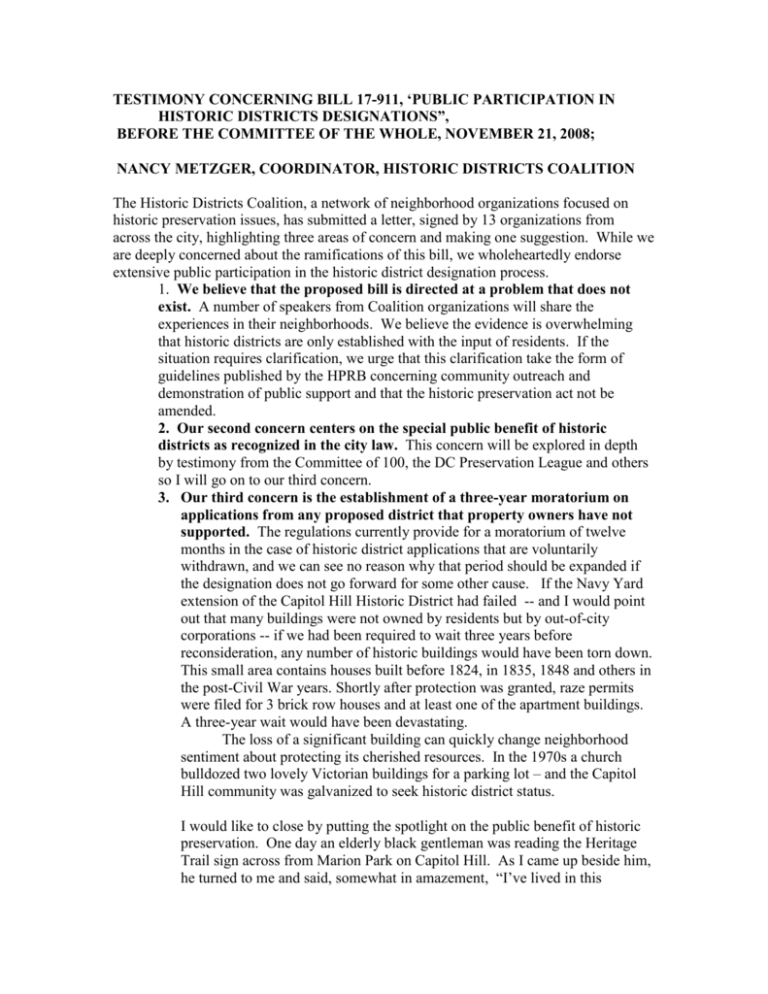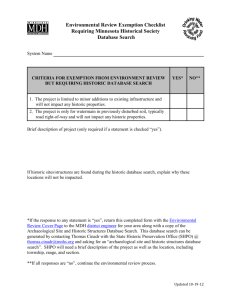The Historic Districts Coalition, a network of neighborhood
advertisement

TESTIMONY CONCERNING BILL 17-911, ‘PUBLIC PARTICIPATION IN HISTORIC DISTRICTS DESIGNATIONS”, BEFORE THE COMMITTEE OF THE WHOLE, NOVEMBER 21, 2008; NANCY METZGER, COORDINATOR, HISTORIC DISTRICTS COALITION The Historic Districts Coalition, a network of neighborhood organizations focused on historic preservation issues, has submitted a letter, signed by 13 organizations from across the city, highlighting three areas of concern and making one suggestion. While we are deeply concerned about the ramifications of this bill, we wholeheartedly endorse extensive public participation in the historic district designation process. 1. We believe that the proposed bill is directed at a problem that does not exist. A number of speakers from Coalition organizations will share the experiences in their neighborhoods. We believe the evidence is overwhelming that historic districts are only established with the input of residents. If the situation requires clarification, we urge that this clarification take the form of guidelines published by the HPRB concerning community outreach and demonstration of public support and that the historic preservation act not be amended. 2. Our second concern centers on the special public benefit of historic districts as recognized in the city law. This concern will be explored in depth by testimony from the Committee of 100, the DC Preservation League and others so I will go on to our third concern. 3. Our third concern is the establishment of a three-year moratorium on applications from any proposed district that property owners have not supported. The regulations currently provide for a moratorium of twelve months in the case of historic district applications that are voluntarily withdrawn, and we can see no reason why that period should be expanded if the designation does not go forward for some other cause. If the Navy Yard extension of the Capitol Hill Historic District had failed -- and I would point out that many buildings were not owned by residents but by out-of-city corporations -- if we had been required to wait three years before reconsideration, any number of historic buildings would have been torn down. This small area contains houses built before 1824, in 1835, 1848 and others in the post-Civil War years. Shortly after protection was granted, raze permits were filed for 3 brick row houses and at least one of the apartment buildings. A three-year wait would have been devastating. The loss of a significant building can quickly change neighborhood sentiment about protecting its cherished resources. In the 1970s a church bulldozed two lovely Victorian buildings for a parking lot – and the Capitol Hill community was galvanized to seek historic district status. I would like to close by putting the spotlight on the public benefit of historic preservation. One day an elderly black gentleman was reading the Heritage Trail sign across from Marion Park on Capitol Hill. As I came up beside him, he turned to me and said, somewhat in amazement, “I’ve lived in this neighborhood all my life and I never knew that church was designed by a black architect.” Mount Jezreel church was designed by Calvin T. S. Brent, who worked right after the Civil War and the church is still standing to inspire that resident only because it is in the Capitol Hill Historic District. In the 1990s, the congregation – part of it at least – wanted to tear it down but when they couldn’t, they moved; the building was repaired and the Pleasant Lane Baptist Church is now the steward of the building and its heritage. The Coalition urges the Council not to pass this bill. Our system presently demands much public participation and provides opportunity for owner objection. The system has worked for 30 years and should be amended only with great care and much thought. Thank you; I will be glad to answer questions about points raised in our letter.







